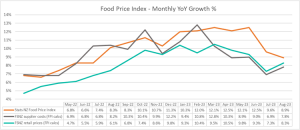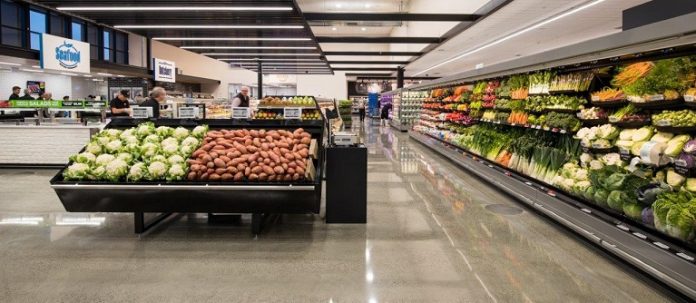The numbers:
- Stats NZ’s Food Price Index (FPI) shows food prices on their FPI basket measure increased 8.9% year-on year in August 2023, compared to 9.6% in July 2023.
- Foodstuffs’ data on the same 45 product categories measured in the FPI basket shows retail prices at the two co-operatives’ 500-plus stores were up 8.3% in August 2023 (vs. 7.3%pa in July), while its suppliers were charging 7.8% more, on average, across the same FPI categories (vs. 6.9%pa in July).
- Earlier, the Infometrics-Foodstuffs New Zealand Grocery Supplier Cost Index (GSCI) revealed costs from suppliers to supermarkets across the wider set of 60,000 products the two co- operatives buy had climbed 6.6% in the year to 31 August 2023 (down from 7.5%pa in July).
“We’re still dealing with elevated transport costs, still facing supplier cost increases, still dealing with the effects of the wet weather. But the work we’re doing to fight inflation is having a sustained effect,” says Foodstuffs NZ Managing Director Chris Quin.
Mr Quin’s comments follow the release of the latest food price index (FPI) figures from Stats NZ, which tracks the prices of individual food items that make up a representative food basket.
While the year-on-year cost of Stats NZ’s basket grew 8.9% in August 2023, average price increases for the same product categories were up 8.3% year-on-year at the stores of the two Foodstuffs’ co-operatives.
Mr Quin says while inflation remains uncomfortably high, here and overseas, the data suggests the co-ops’ 500-plus local grocers are managing their operations well within the current environment.
“The reason we’re comparing Stats NZ’s monthly FPI figures with our own is so we can see how we’re doing at resisting the current inflationary environment compared to the wider food industry,” he said.
“This is the sixteenth month in a row that Foodstuffs’ price increases on the same product categories measured in the FPI basket have risen at a lower rate. It shows our co-ops are working hard to keep prices down. We know suppliers are helping too, by managing their cost increases during the month.”
Foodstuffs’ data shows prices on some seasonal items were significantly cheaper than in August 2022, including avocados (down 25%), green kiwifruit (down 14%), and lamb shoulder chops (down 11%).
“With the longer daylight hours, and El Niño moving into position, growing conditions are expected to improve around the country. Cauliflowers are great buying, and asparagus will soon be hitting the shelves,” Mr Quin said.
“At the same time, the California grape crop was severely hit by Hurricane Hilary last month, and that drop in supply will soon impact grape prices here. Likewise, courgettes are low in supply now that the Australian season is over.”
Mr Quin says such examples show how prices are still largely influenced by suppliers and seasonality. Foodstuffs’ data on the same product categories measured in the FPI basket shows supplier costs – what growers, importers, and manufacturers charged the co-ops for the same goods – rose 7.8% in August 2023 versus a year ago.
“The cost of goods from our suppliers is the biggest part of shelf prices. On average, supplier costs for the same product categories as the FPI basket have been rising at a faster rate than retail prices. Often, we can absorb that, but sometimes we can’t,” he said.
Earlier this week, the latest Infometrics-Foodstuffs New Zealand Grocery Supplier Cost Index, which tracks the entire range of roughly 60,000 products sold to the Foodstuffs’ co-ops, showed the rate of supplier cost increases slowing, to 6.6% in the year to August (down from 7.5%pa in the year to July).
Supplier costs rose across the board month-on-month, particularly in frozen foods, which saw an annual rise of almost 9%pa, overtaking produce costs, which were up 8.5%pa. Food input costs were growing considerably higher, however, with vegetable inputs up 30%pa, and sugar, confectionery, and fish all still seeing double-digit annual growth.
“The feedback we’re hearing is that wages and product costs are the major issues suppliers are facing,” Mr Quin said. “On the positive side, we are seeing improved levels of stock availability from suppliers. In recent years this has been a struggle, but there’s now greater amounts of stock to hand, which helps with customer choice and availability.
“Multiple factors are feeding food inflation, at all stages of the supply chain, from the cost of raw ingredients like sugar and rice, through to the cost of shipping and fuel. They all ultimately affect what we pay at the checkout.
“It’s been a difficult winter but there are positive signs ahead. The days are getting longer and warmer, which means better growing conditions for some fresh fruit and veggies, and we’re seeing improving road conditions for freight. We hope all those positive trends continue and that inflation loses steam,” he said.

Foodstuffs analysis against FPI data (May 2022 – August 2023).


